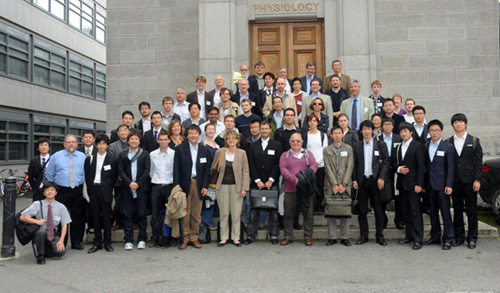Leading Molecular Nanotechnologists Reveal New Research at Trinity Conference
Posted on: 16 September 2011
Scientists and engineers from 21 countries met recently at an international conference in Trinity College Dublin to discuss advances in organic electronics, photonics and nanotechnology.
A breath-taking range of new applications was revealed by world-leading speakers including developments in explosives and landmine detection; an artificial prosthetic retina to restore sight; efficient low-cost flexible solar cells; and polymer photonics bringing real-time face-to-face communications to individual households.

Conference delegates at TCD.
Commenting on the significance of the conference, conference chairman and CRANN investigator Prof. Werner Blau, TCD School of Physics stated: “Increasing concerns among the public call for the replacement of environmentally harsh processing conditions associated with current advanced technologies by adaptable, sustainable and environmentally benign organics. In the areas of flexible organic photovoltaics and OLED based displays, we have already seen commercial products coming on stream, such as by the conference co-organisers, Dublin-based company Solarprint. Significant progress in the communications, biomedical and sensing sectors which will ultimately result in improvements to the quality of life for people worldwide was demonstrated at the conference.”
Among the highlights of the International Conference on Organic Photonics and Electronics 2011 / the 12th International Conference on Organic Nonlinear Optics were: Dr Graham Turnbull of the University of St. Andrew’s, Scotland presenting new results for ultrahigh sensitivity detection of explosives and landmines using organic laser technology; while Prof Gugliemo Lanzani of the Centre for Nanoscience and Technology, Milan, Italy demonstrated significant progress in the development of an artificial prosthetic retina to give at least partial sight back to blind people by coupling soft organic materials directly to neural tissue in the nanoscale.
Prof Yasuhiro Koike, Keio Photonics Research Institute, Yokohama, Japan and Prof Seizo Miyata Tokyo Institute of Technology, Japan both described significant advances in polymer photonics to bring real-time face-to-face communications to individual households, without the need for a visible machine interface, thereby making communications accessible to all people worldwide regardless of their educational background or age.
The offer by the International Scientific Advisory Board to bring ICONO/ICOPE to Dublin in 2011 represents recognition of Ireland as a location for advanced research and industrial development in this high-tech area. The conference moves around the globe from the Americas to Asia/Pacific to Europe. It is timely in the run-up to the City of Science 2012 in Dublin.
Organic Electronics and Optoelectronics is a sub-discipline of both Material Science and Nanotechnology. A Thomson-Reuters report in late 2010 placed Ireland 8th globally for materials science research based on citations per publication for the decade 2000-2010. CRANN researchers were responsible for more than 70% of the outputs leading to this national ranking. In Nanotechnology, Ireland’s global ranking is sixth in terms of both the quality of its publications and the volume output per capita. Nanotechnology is a key enabling technology which underpins the ICT, medical device, and pharmaceutical sectors and hence is critical to Ireland. At present, it is estimated that 10% – about €15 billion – of Ireland’s annual exports are associated with nanotechnology and that there are in excess of 150,000 employees working in companies in which nanotechnology plays an important enabling role.
The Dublin conference received financial support from Fáilte Ireland, Science Foundation Ireland and CRANN, the Trinity College based Centre for Research on Adaptive Nanostructures and Nanodevices.
